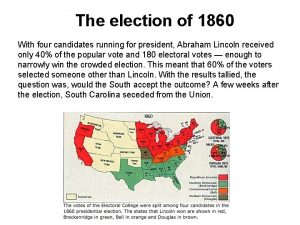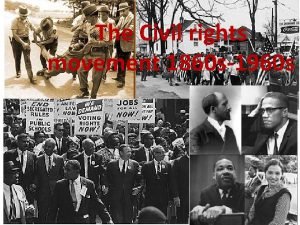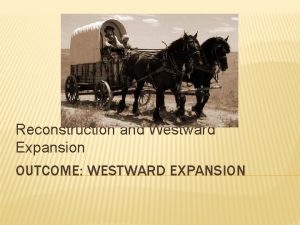Westward Movement Notes Westward Movement 1860 1898 The















- Slides: 15

Westward Movement Notes


Westward Movement 1860 -1898 • The mid-nineteenth century was a period of great change and development west of the Mississippi River. For the American Indians, these years brought disaster. For most other Americans, the West offered opportunity and freedom.

Conflicts with Native Americans • As Americans continued to migrate westward in search of farmland other economic opportunities, they continued to grab space that the government has set aside for Native Americans.

• Fort Laramie Treaty guaranteed the Plains Indians that they would be left alone in their defined territories. In exchange for ceasing to wander the Great Plains as migratory hunters, the Plains Indians accepted money and guarantee of a yearly delivery of supplies.

• In 1862 Congress delayed payments of the annuities. • Some Indians began starving. • Chief asked traders to give his people food on credit. • His request was denied. • They began an uprising that led to the deaths of hundreds of settlers.

• Many Native Americans left their reservations to hunt buffalo on the open plains. • In addition, when American settlers violated the treaties, the Native Americans saw no reason to abide by them. • In 1876 the Lakota left their reservation to hunt near the Bighorn Mountains in southeastern Montana. • The U. S. government sent army troops after the Lakota.

• George A. Custer, commander of the Seventh Cavalry, divided his forces and attacked the Lakota and Cheyenne warriors camped at the Little Bighorn River. • The Native Americans killed all the soldiers. • Sitting Bull and his followers fled to Canada. • Others were forced to return to the reservation.

• Some Americans had opposed the treatment of Native Americans. • Some people thought that the situation between whites and Native Americans could be improved if Native Americans could assimilate, or be absorbed into American society as landowners and citizens.

• This included breaking up reservations into individual allotments, where Native Americans would live in families and support themselves. • This became the policy when Congress passed the Dawes Act in 1887. • The Dawes Act was a failure. • Few Native Americans had the training or enthusiasm for farming or ranching. • They found the allotments too small to be profitable.

Settling the West The federal government was eager to settle the West as quickly as possible. Even during the dark days of the Civil War, the federal government continued its efforts to move people westward

Government Land Acts included: • Homestead Act —Anyone who staked a claim to up to 160 acres of land could keep it if he or she farmed the land lived on it for five years. • Pacific Railway Act —Railroad companies could apply for land grants on which to develop and build a transcontinental railroad system • Morrill Act —Granted 17 million acres of federal land to the states, with the requirement that they sell this land use the money to found agricultural and engineering colleges

• Farming—the Great Plains had abundant grassy land, perfect for cattle to graze on or for cultivation of grain. • US Department of Agriculture was created to assist with issues of lack of water and timber. • Ranching—as ranching spread westward, the government determined that ranchers could allow their cattle to graze freely on the open range. Water was scarce in the South west and ever successful rancher owned property near a water source

• Cowboys were a mixed group of feedmen, Mexicans, Mexican Americans, and Civil War veterans. • A combination of factors ended the cattle boom around 1890. • Ranching had been so successful that the supply of cattle was starting to exceed the demand, which meant that prices for beef were falling • The invention of barbed wire allowed ranchers to fence off their land so that others could not have access to the water or grass on their property.

• Mining—The California Gold rush ushered in an era of mining in the West. • In 1859 a prospector named Henry Comstock staked a claim in Six-Mile Canyon, Nevada. The sticky, bluegray mud found there turned out to be nearly pure silver ore. • News of the strike made that area a boomtown of nearly 30, 000 people. • The Comstock Lode turned out to be worth more than $500 million.
 American romanticism 1800 to 1860 worksheet answers
American romanticism 1800 to 1860 worksheet answers Whig party beliefs
Whig party beliefs South carolina 1860
South carolina 1860 American romanticism 1800 to 1860
American romanticism 1800 to 1860 Map of 1860
Map of 1860 Decreto 1860 de 1994
Decreto 1860 de 1994 1860
1860 Party platform definition
Party platform definition American reform movements between 1820 and 1860
American reform movements between 1820 and 1860 Election of 1860 pie chart
Election of 1860 pie chart Chapter 12 religion romanticism and reform
Chapter 12 religion romanticism and reform Border states in 1860
Border states in 1860 American romanticism 1800 to 1860 worksheet answers
American romanticism 1800 to 1860 worksheet answers Arthur and lewis tappan apush
Arthur and lewis tappan apush South africa 1860
South africa 1860 American romanticism 1800 to 1860 worksheet answers
American romanticism 1800 to 1860 worksheet answers





























